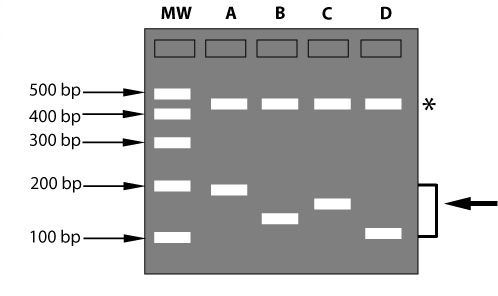Polymorphic versus monomorphic DNA markers
DNA markers are useful if they reveal genetic differences between two individuals. These markers are called polymorphic markers, while markers that do not discriminate are called monomorphic markers (figure below). When a marker is polymorphic in a certain population, it can be used for selection within this population. However, a marker that is polymorphic in one population, might be monomorphic in another population and thus be useless there. Different forms of a DNA marker are called marker alleles.
|
|
|
Example of a monomorphic and a polymorphic DNA marker. Some types of DNA markers are made visible as bands on gels. MW: molecular weight DNA ladder, used to estimate the sizes of the DNA fragments. The shorter a fragment, the faster it moves through a gel and the further it has advanced from the gel slots at the top. bp: sizes of DNA fragments are measured in base pairs. The gel picture shows a monomorphic DNA marker (indicated by an asterisk) and a polymorphic DNA marker (indicated by the arrow on the right) in genotypes A, B, C and D. It depends on the population tested whether a marker is monomorphic or polymorphic: in case there is another genotype E, the marker indicated with an asterisk might show a band at a different place. Then this marker is polymorphic. |
